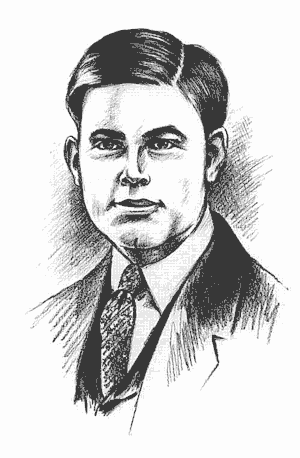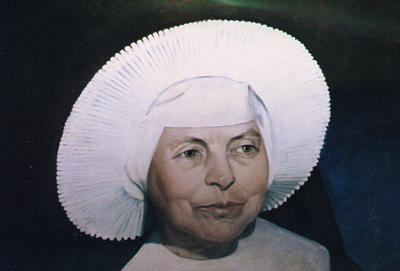
Notre Dame's Grotto / by Dorothy V. Corson


Researching Joyce Kilmer
There was very little in the University Archives about Joyce Kilmer and only a few mentions of lectures he made on campus. A few letters exchanged with Charles O'Donnell and John W. Cavanaugh, arranging those lectures in 1914, gave no evidence to pinpoint his first visit to Notre Dame prior to that first lecture. Sometime before, or after, that first lecture O'Donnell and Kilmer must have become friends and correspondents. Father Charles O'Donnell was also a chaplain where Kilmer was stationed during the war in Europe. He corresponded with Kilmer's widow, Aline, until his death.
One publication did have a picture of Kilmer's daughter, a Benedictine nun, and his youngest son, Christopher. They were photographed together during a celebration honoring Kilmer. It might be almost impossible to locate a lay person, but a religious was another matter. Although the chances that his daughter might still be living 57 years later were rather slim, it seemed worth a try.
Within minutes Kilmer's daughter, Sister Michael, was on the line in St. Cloud, Minn. She said she was sorry to report that, to her knowledge, no tree had been recognized as the one that inspired her father's poem. She said her older brother might be able to remember more about it and she offered his telephone number in Vienna, Virginia.
Kenton Kilmer, oldest child of Joyce Kilmer, was most hospitable. He confirmed his sister's impression. He said he also had a letter written by his mother, to another inquirer, explaining the origin of the poem "Trees" as she knew it. He offered to send anything he had that might be of help. Many places, he explained, including Kilmer's alma mater, Rutgers, had trees they felt had inspired Kilmer's poem.
The material he sent indicated that Richmond, NH, Prairie du Chien (Campion), and a Catholic Summer School and Retreat House on the shores of Lake Champlain, were other places said to have trees that may have inspired Kilmer's poem. He included pictures of the family home, its trees, and a copy of the poem handwritten by Kilmer at the time. He then described when and where this much loved poem was written.
He said "Trees" was written at Kilmer's home in Mahwah, New Jersey on February 2, 1913. It was written in the afternoon in the intervals of some other writing. The desk was in an upstairs room, by a window looking down a wooded hill. It was written in a little notebook in which his father and mother wrote out copies of several of their poems, and, in most cases, added the date of composition. On one page, he said, the first two lines of "Trees" were written, with the date, February 2, 1913, and on another page, further on in the book, was the full text of the poem. It was dedicated to Kilmer's wife's mother, Mrs. Henry Mills Alden, who was endeared to all her family.
Father Schidel, a Holy Cross priest on campus, said he, too, had heard the same story over the years. He asked Father Charles Carey, a nephew of Father Charles O'Donnell -- the poet Laureate and Kilmer's good friend -- if his uncle had ever mentioned Joyce and the Grotto.
Father Carey said he did remember one comment his uncle made about walking around the lake and Grotto lawn with Kilmer. He said his uncle told him he and Kilmer had stopped to admire what they both felt was a perfect tree, the one sheltering Our Lady and the Grotto perhaps? This could have occurred before the 1913 poem was written or, more likely, afterwards, in discussing it.
A book about the campus written by a Holy Cross priest, Father Sigmund Jankowski, who built the St. Stanislaus Grotto in South Bend, mentioned how Joyce Kilmer visited their English class and recited his famous poem. This priest began his studies at Notre Dame in the fall of 1913, eight months after it was written and just weeks after it was published. He described his remembrance of him in his book:
. . . It was one of my happy graces to have Father [Charles] O'Donnell as a teacher in English. Into our classroom one day, he invited his fellow-poet, Joyce Kilmer, the author of "Trees." He himself recited his immortal lines with a commanding artistic touch. He was a mild-mannered man whose eyes betrayed a wealth of inspiring thoughts, and also a definite spark of courage, enabling him later to give his life for his country in World War I. . . (172)
Sister Madeleva, former President of Saint Mary's College, and a poet, was also a friend of Joyce Kilmer from her early days as a nun. Sister Madeleva took a summer class in creative writing from Fr. Charles O'Donnell at St. Mary's and through him she met Kilmer. In her autobiography, My First Seventy Years, she speaks of her friendship with them:

More than once Joyce Kilmer came with Father O'Donnell to visit. Their minds were quick with poems waiting to be written. The importunities of war pressed. Both men volunteered for service. Both went overseas. Joyce was killed in action on July 30, 1918, near Ourcq in France and buried beside a stream that bears the same name. Father blessed his grave before coming home.(173)
There was no grade transcript of Sister Madeleva's creative writing class with Father O'Donnell and her letters and papers gave no clues to her first meeting with Kilmer on the St. Mary's campus. However, one of her poems about candle-light could have been written for the Grotto. This portion of it would be an inspiration to all who visit there.
|
Candle-Light Day has its sun,
Sister M. Madeleva, C.S.C.(174) |